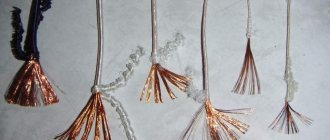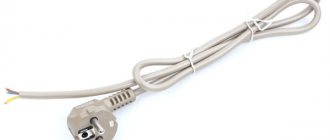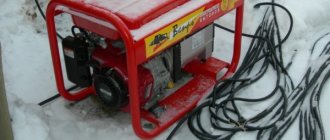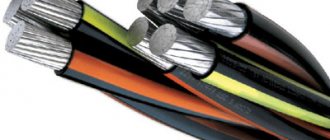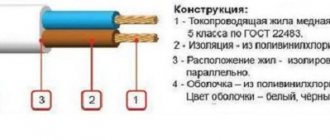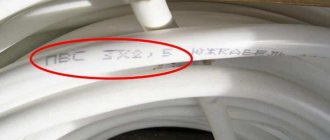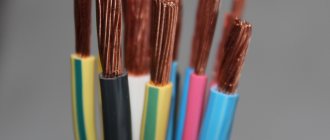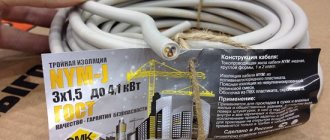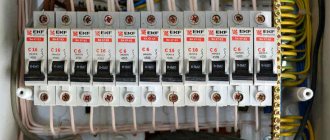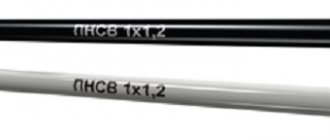When constructing new facilities and reconstructing old ones, with an increase in the number of electricity consumers, the construction of power lines with high performance indicators is required. The cable is suitable for laying new routes; it meets all modern standards and requirements for current transmission and distribution. The conductor is often used in areas with cold winters, when the air temperature can drop to -40 degrees.
The advantages of the cable include long service life, resistance to aggressive environments and mechanical stress. If all GOST and PUE requirements for acceptance, storage, installation and operation are met, the wire can be used for 30-40 years.
The most popular conductors include SIP-3 wires with cross-sections of 1x50, 1x70, 1x95. Foreign analogues include SAX and PAS wires.
Wire design
The structure of the SIP-3 cable does not involve the use of a zero load-bearing element. It includes:
- The current-conducting part is made of AlMgSi wires, while its own weight is evenly distributed over the cross-section and length.
- Insulation coating, which is represented by light-stabilized cross-linked polyethylene PEX.
The insulation material has the same technical qualities as solids. Indicators such as resistance to destructive factors and service life are higher for polyethylene. The positive features of the insulator include:
- resistance to high temperatures, including boiling water;
- high dielectric qualities;
- not biodegradable;
- cracks do not appear due to temperature changes;
- excellent tensile and tensile strength;
- not exposed to chemically aggressive substances.
Why are wires not made according to the standard?
This is done with one goal - to win the competition from other manufacturers by reducing the price of the product. The issue of reliability fades into the background here.
All this is designed for a technically illiterate buyer who, when he comes to the store, will choose exactly the product that is cheaper. And when purchasing it, the seller will also convince you that this cable meets certain technical conditions and is completely safe to use.
The big problem is that cables manufactured according to GOST requirements can very rarely be found in stores. The plant produces it for the most part for use on an industrial scale. Some stores sell such products only on order.
Based on the above, try not to think about what to choose: GOST or TU cable. It is definitely better to always purchase only one manufactured in accordance with GOST , and even if it is not available in the store, it is advisable to place an order and wait a few days rather than install products with pre-lowered characteristics.
The only advantage of a cable produced according to technical specifications is the ease of stripping the insulation.
With GOST wire, even when using electrician’s knives with a “heel,” big problems can arise.
Only well-known and high-quality brands do a good job - Knipex, Jocari. And then only on condition of well-sharpened blades.
And with TU, the insulation can be removed without any problems using any Chinese knives. In fact, it is a kind of heat shrink wrapped over several cores.
Features and Benefits
SIP-3 is characterized by the absence of a zero core, and it can be installed without additional supporting structures, such as a cable, cable, guy wire. The advantages of the wire include:
- high fire safety;
- the ability to carry out repairs on a working highway;
- no need to use insulator traverses;
- Possibility of installation in city conditions in compliance with safety and construction requirements;
- resistance to tensile stress prevents line breakage as a result of falling branches and other objects;
- expansion of the security zone;
- SIP and bare cable can be mounted on one support;
- the wires do not overlap, which eliminates short circuit;
- product reliability, uninterrupted operation of consumers;
- ease of care and maintenance;
- high speed of repair work;
- reduction of voltage losses on routes;
- excellent performance characteristics of SIP-3 wire;
- reducing costs when installing a new power line;
- mounted on low power transmission line supports;
- You cannot connect to the power line without special permission.
Types of SIP and the difference
Today, the most widespread are 3 types of SIP with voltage 0.4 kV:
- SIP-1 is a wire with a bare, non-insulated load-bearing core. The supporting core is made of aluminum alloy, without any protective sheath.
- SIP-2 is a wire with an insulated load-bearing neutral core. Here the zero core is made of aluminum alloy covered with insulation on top. And the phase conductors are also insulated and twisted around it.
- SIP-4, SIP-5 - a wire with all four insulated conductors of the same cross-section made of aluminum.
Each plant must adhere to the current GOST when producing self-supporting insulated wires. However, some may deviate from the rules in order to save money. The result is different core material, different insulation, and different compaction coefficients.
Even the twists of the cores may be different - left-handed or right-handed.
Please note that in SIP1 and SIP-2 the load-bearing core must be made of aluminum alloy, which is less susceptible to stretching. As a result, during long-term operation of overhead lines, there will be no sagging of wires in anchor spans. Accordingly, there is no need to re-tighten and adjust the sag arms every 3-6 years during maintenance and major repairs.
SIP-4 is very susceptible to this because of the aluminum load-bearing cores. And you will have to deal with sagging here as well as on overhead lines with bare wires.
Application
The cable is used when installing overhead power lines. The cable transmits and distributes electrical energy between consumers; the alternating current parameters in the network must correspond to the characteristics of 20 kV (35 kV maximum), 50 Hz. Laying is carried out in areas with temperate, cold and tropical climates in industrial and marine areas (sea coast, shore of a salt lake, areas with saline sand).
The conductor is used when constructing sections of routes, branches and taps in compliance with the rules of voltage distribution. The self-supporting wire SIP-3 can be installed in urban areas, rural areas, and uninhabited areas where it is necessary to lay long-distance mains with minimal voltage losses. Thanks to the possibility of installation on supports installed at a large distance from each other, the cable is laid over historical and architectural monuments. This does not disrupt the overall composition.
The wire is applicable only for connecting the first category of consumers. Due to the possibility of selecting the required cross-section, a reduction in material costs for the construction of additional substations is achieved.
Specifications
Technical characteristics of SIP-3 are presented by the following parameters:
| Rated voltage | 20 kV or 35 kV; |
| Temperature limits to maintain performance | -50 / +50 degrees; |
| duration of service | 45 years; |
| installation at temperature | above -20 degrees; |
| short circuit parameters under which the network continues to operate | temperature 250 degrees, duration 5 seconds; |
| emergency work | maximum 8 hours at 130 degrees; |
| heating the core | 90 degrees; |
| breakdown voltage in the network at 20 kV | 24000 V; |
| Elek. SIP-3 resistance per 1 km | 0.125-1.91 Ohm depending on the cross-section. |
The tests are carried out as follows: the wire is kept in water for 10 minutes, and the temperature of the liquid can range from +10 to +30 degrees. After this, a standard SIP is connected to a network with a voltage of 4 kV, protected at 20 kV - 6 kV, protected at 35 kV - 10 kV and a frequency of 50 Hz.
Purchase
You can buy a wire with the most favorable conditions by contacting our company. We work with trusted manufacturers and do not use the services of intermediaries, which allows us to reduce the cost of cable and wire products to a minimum. Placing an order is done in the fastest and most convenient way - through the website or by email. After receiving your questionnaire, we immediately begin to formulate the terms of purchase.
We work with individuals and legal entities, engaged in wholesale and retail trade. Complete with the product, the customer receives a certificate of conformity and a quality certificate. If necessary, our consultants will answer all your questions. You can buy products from the assortment available in the warehouse or from the manufacturer to order. The price of SIP-3 wire depends on the delivery conditions and order volume. For regular customers, we have provided a system of discounts and special offers.
SIP fittings
The SIP cable has its own components designed for quick and safe installation. Linear fittings are presented in a wide range:
- piercing clamps are compatible with any type of cable. The clamps provide a tight connection due to the fact that the insulation from the core is not removed. After installing the clamps over the insulation, tighten the fixing bolts. At this time, the piercing teeth, passing through the insulation, come into contact with the metal of the core;
- Branch fittings are used to provide tension support for the cores. The clamps have a mechanism whose operating principle simplifies the process of installing and dismantling the cable without special equipment. The tensioner can be used to suspend the cable from any surface;
- support and anchor fasteners are designed to secure the clamps. Bandage tape is used along with hooks and clamps. Any fastener is resistant to corrosion and temperature changes.
Spiral matings
Products are manufactured in accordance with technical specifications 3349-033-27560230-33, and their installation is carried out on the basis of standard document 16.K71-272-98. The purpose of the ties is to fasten insulated SIP-3 wires to insulators. They can have different designs and carry out single (for BC-...-01) and double fastening (carried out within one insulator).
The strength of the connection established by the standards makes it possible to eliminate damage to the supports in the event of a cable break or other types of accidents. If the load level exceeds the calculated one, then the conductor slips in the knitting. For single knitting, a strength of 3 kN is provided, for double knitting - 0.5 kN.
The single connection device provides for the expansion of the annular part of the binding and its installation on the neck of the insulator. The branches of the product are wound around the wire, which assumes a lateral position of the latter in relation to the insulator.
The double connection device involves mounting the ring parts of two ties on the insulator neck, the branches are directed in opposite directions and wound onto the cable. The conductor itself passes over the insulator cap.
Difference between GOST and TU cables
In Soviet times, factories always produced products in accordance with GOST. GOST is a state standard from which you have no right to deviate. If the product said it was a 4mm2 cable, then it really was a real 4mm2.
Much later, in order to increase the economic profit of the enterprise, their own technical conditions were invented. The technical specifications indicate the requirements for any substance from which the cable is made, as well as the procedures governing the implementation of these requirements.
On the one hand, there doesn’t seem to be much difference compared to GOST. However, this allowed the manufacturer to begin reducing the cross-section of the cores, the thickness of the insulation, etc. They simply issue technical specifications for one specific product and prescribe in them what they themselves require. As a result, you can observe the following difference between seemingly identical cable brands:
And all these deviations from GOST were prescribed by the plant in the technical specifications, thus allegedly not violating the standards.
There are two main methods used here:
- For example, you can seem to keep the cross-section, but save on burning copper, or add some impurities to it.
- The second method is that if you can provide sufficient resistance to the core, you are allowed to reduce its cross-section.
All this led to manipulation and dangerous savings in the manufacture of cable products.
When you think about saving when choosing a cable, know that there are two main violations when manufacturing it according to specifications:
- the cross-section of the cores is reduced
- the thickness of the insulating layer decreases
